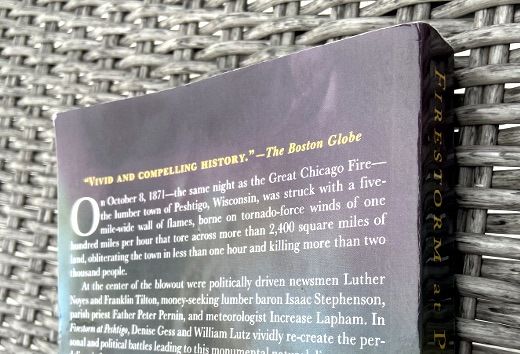My Takeaways from Firestorm at Peshtigo

Even the most casual observer of history will know about the great fire in Chicago, Illinois in the US in 1871. From the legend of Mrs. O’Leary’s cow to the city’s destruction and rebirth, it is the stuff of legends. But do they – or you – know of a fire equally as intense that likely killed ten times as many people… just a few hours away… on the same day?
Don’t feel bad if you don’t – I didn’t either until I moved closer to where that second fire was and read a story about it, Firestorm at Peshtigo: A Town, Its People, and the Deadliest Fire in American History by Denise Gess and William Lutz.
Peshtigo, Wisconsin today is a small city surrounded by a town of the same name and located in northeast Wisconsin, not too far from where what you are reading was written. In comparison to its former self before the fire in 1871, it pales in comparison. Even with its proximity to me, I have never been there and never hear much about it otherwise. But that former self was quite an industrial city in its time, as it was the home to forest logging, wood mills and the manufacturing of wooden products.
Gess and Lutz dig into the history of the area from a variety of sources and have crafted a tale of good times and bad and the people affected by it. As I was intrigued by the story that claimed the lives of at least a thousand people, I of course had several takeaways from it.
There was something always burning – The forests of Wisconsin and the upper US Midwest were home to an abundance of trees. Common practice was to cut down trees and burn the remaining tree stumps so that the land could be used for farming. As a result it seemed like there was always something burning in and around Peshtigo, and that is perhaps why people did not flee the area as quickly before the fires reached their pinnacle.
The beginnings of meteorology – Today it’s too easy to see the weather forecasts down to the hour, but that was far from the case in the late 1800’s. That being said it was the earliest days of weather tracking and meteorology that got its start in the military services. From this tracking it was observed that the temperatures in the area were extremely hot and dry for October and as well there were fires and tornadoes not only in the Peshtigo area but in several cities along Lake Michigan.
Ties between Peshtigo and Chicago – Speaking of Lake Michigan, more than the weather were a bond between these two cities that are located by it. William Ogden was an industrialist from New York and the first mayor of Chicago among other contributions to that city. He also owned a mill and woodenware factory in Peshtigo. He was back in New York on October 8, 1871 and traveled back to the Midwest after he heard the news. His promises to rebuild in Peshtigo never materialized and with the fires went that great industry of the area.
I need to visit Peshtigo now – Reading Firestorm at Peshtigo reminded me of when I read The Great Halifax Explosion and I vowed to one day visit that area. As I am so close to Peshtigo it is on my short list of places to go this summer. The history geek in my will want to take it all in, though I am not sure if the family will share the same enthusiasm in it, but there’s one way to find out.
Firestorm at Peshtigo was a well-told tale of history, and I highly recommend it not only to anyone who lives in the area where Peshtigo is, but anywhere who has an interest in such a sad but unique time. At the end the book the notes section is probably the best I have read in a non-fiction piece, as it is a narrative and not just a clinical list of references. Calling back the family reference, it was my wife’s cousin, a retired librarian, who recommended the story to me. As I pass along all books I read, I am sending it to my own cousin, who is also a retired librarian, as I know she is a voracious reader and I think will equally enjoy this story.
This is from The Hot Iron, a journal on business and technology by Mike Maddaloni.
Did you enjoy this? Subscribe to The Hot Iron by RSS/XML feed or Read by Email
Book Take-Aways • (0) Comments • Permalink
